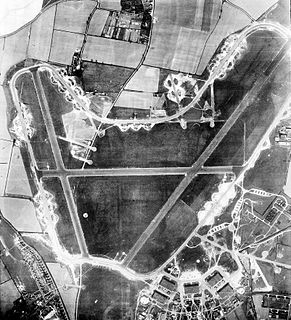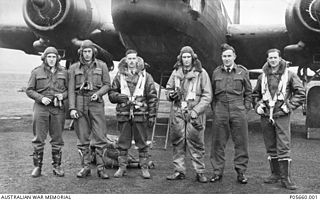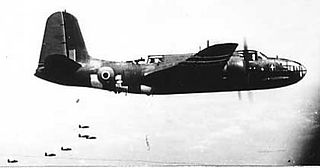No. 8 Group was a Royal Air Force group which existed during the final year of the First World War and during the Second World War.
No. 75 Squadron of the Royal Air Force operated as a bomber unit in World War II, before being transferred to the Royal New Zealand Air Force in 1945.

No. 311 (Czechoslovak) Squadron RAF was a Czechoslovak-manned bomber squadron of the Royal Air Force in the Second World War. It was the RAF's only Czechoslovak-manned medium and heavy bomber squadron. It suffered the heaviest losses of any Czechoslovak formation in the RAF. In the Second World War 511 Czechoslovaks serving in Allied air forces were killed. Of these 273 (53%) died while serving with 311 Squadron.
No. 630 Squadron RAF was a heavy bomber squadron of the Royal Air Force during the Second World War.

No. 21 Squadron of the Royal Air Force was formed in 1915 and was disbanded for the last time in 1979.

RAF Horsham St Faith is a former Royal Air Force station near Norwich, Norfolk, England which was operational from 1939 to 1963. It was then developed as Norwich International Airport.

Royal Air Force Kings Cliffe or more simply RAF Kings Cliffe is a former Royal Air Force satellite station located near Kings Cliffe, Northamptonshire, 12 miles (19 km) west of Peterborough in Cambridgeshire. The airfield was built with hard-surfaced runways and a perimeter track, these were extended early in 1943.

No 620 Squadron was a squadron of the Royal Air Force during World War II. During its existence it served as a bomber squadron, airborne forces and a transport squadron.

No. 458 Squadron RAAF was a Royal Australian Air Force squadron that operated during World War II. It was formed in Australia under Article XV of the Empire Air Training Scheme. The squadron flew various versions of Vickers Wellington bombers, first in Europe and later in the Middle East. It was disbanded in mid-1945, following the conclusion of hostilities in Europe.

No. 463 Squadron RAAF was a Royal Australian Air Force heavy bomber squadron during World War II. The squadron was formed in the United Kingdom in late 1943 from personnel and aircraft allocated from No. 467 Squadron RAAF. The squadron was equipped with Avro Lancaster bombers and flew its first raids on Germany immediately after being formed. Operating as part of RAF Bomber Command No. 463 Squadron conducted raids against cities, industrial facilities and military targets in Germany, France and Norway throughout 1944 and until the end of the war in May 1945. Following the war, the squadron evacuated Allied prisoners of war from Europe until it was disbanded in late 1945.
No. 158 Squadron RAF was a World War I proposed ground attack squadron that did not become operational in time to see action, and a World War II bomber squadron. After World War II had ended in Europe the squadron operated in the transport role until disbandment in December 1945.

No. 320 (Netherlands) Squadron RAF was a unit of the Royal Air Force during World War II formed from the personnel of the Royal Netherlands Naval Air Service.

The 350th Fighter Group was an air combat unit of the United States Army Air Force formed in 1942 and inactivated in 1945. The fighter group consisted of 345th, 346th and 347th Fighter Squadron. The group was formed in England in 1942 flying Bell P-39 Airacobras and participated in the Mediterranean and North African Campaigns of World War II. 350th Fighter Group was based in North Africa, in Algeria and Morocco from January to July 1943. They then moved on to the Mediterranean islands of Sardinia and Corsica in November 1943 and February 1944 and were based in Italy in from September 1944 to July 1945. After the group was inactivated on 7 November 1945 at Seymour Johnson Air Force Base following the end of the war. It was redesignated the 112th Fighter Group and placed under the control of the Pennsylvania Air National Guard in 1946.

Tortorella Airfield is an abandoned World War II military airfield in Italy. It was located 9.4 kilometers east-northeast of Foggia, in the Province of Foggia. The airfield was abandoned and dismantled after the end of the war in 1945.
No. 4 Group was a Royal Air Force group, originally formed in the First World War, and reformed in the wake of the Second World War, mostly part of RAF Bomber Command, but ending its days in RAF Transport Command.

The No. 342 Squadron also known in French as ''Groupe de Bombardement n° 1/20 "Lorraine", was a Free French squadron in the RAF during World War II.
No. 114 Squadron was a squadron of the British Royal Air Force. It was first formed in India during the First World War, serving as a light bomber squadron during the Second World War and as a transport squadron post-war. It was last disbanded in 1971.
No. 326 Squadron RAF was a Free French fighter squadron given a Royal Air Force squadron number during World War II.
No. 328 Squadron RAF was a Free French fighter squadron given a Royal Air Force squadron number during World War II.
The No. 346 Squadron RAF was a French Air Force bomber squadron given a Royal Air Force squadron number during World War II.










